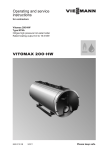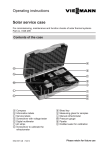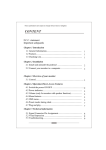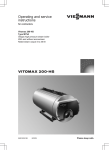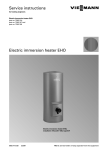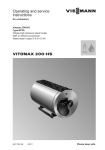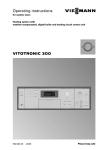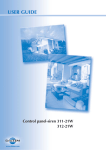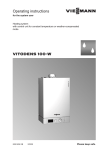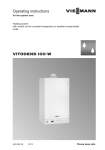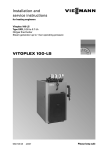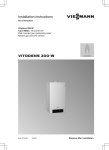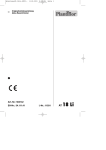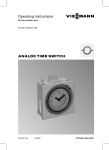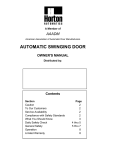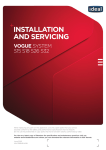Download User Manual - Vitomax 200
Transcript
Operating and service instructions VIESMANN for contractors Vitomax 200-LW Type M62A Oil/gas low pressure hot water boilers Rated output 2.3 to 6.0 MW VITOMAX 200-LW 5592 607 GB 3/2009 Please keep safe. Safety instructions Safety instructions Please follow these safety instructions closely to prevent accidents and material losses. Safety instructions explained Danger This symbol warns against the risk of injury. ! Please note This symbol warns against the risk of material losses and environmental pollution. Note Details identified by the word "Note" contain additional information. ■ all current safety regulations as defined by DIN, EN, DVGW, TRGI, TRF, VDE and all locally applicable standards, ■ Gas Safety (Installation & Use) Regulations – the appropriate Building Regulation either the Building regulations, the Building Regulation (Scotland), Building Regulations (Northern Ireland), – the Water Fittings Regulation or Water Bylaws in Scotland, – the current I.E.E. Wiring Regulations. Target group If you smell gas Regulations Observe the following when working on this system ■ all legal instructions regarding the prevention of accidents, ■ all legal instructions regarding environmental protection, ■ the Code of Practice of relevant trade associations, 2 Danger Escaping gas can lead to explosions which may result in serious injury. ■ Never smoke. Prevent naked flames and sparks. Never switch lights or electrical appliances ON or OFF. ■ Close the gas shut-off valve. ■ Open windows and doors. ■ Remove all people from the danger zone. ■ Notify your gas or electricity supplier from outside the building. ■ Shut off the electricity supply to the building from a safe place (outside the building). 5592 607 GB These instructions are exclusively designed for qualified personnel. ■ Work on gas equipment must only be carried out by a qualified gas fitter. ■ Work on electrical equipment must only be carried out by a qualified electrician. ■ The system must be commissioned by the system installer or a qualified person authorised by the installer. Safety instructions Safety instructions (cont.) If you smell flue gas Danger Flue gas can lead to life-threatening poisoning. ■ Shut down the heating system. ■ Ventilate the boiler room. ■ Close all doors leading to the living space. Working on the system ■ When using gas as fuel, also close the main gas shut-off valve and safeguard against unauthorised reopening. ■ Isolate the system from the power supply and check that it is no longer 'live', e.g. by removing a separate fuse or by means of a main isolator. ■ Safeguard the system against unauthorised reconnection. ! Ancillary components, spare and wearing parts ! Please note Spare and wearing parts which have not been tested together with the heating system can compromise its function. Installing non-authorised components and non-approved modifications/conversion can compromise safety and may invalidate our warranty. For replacements, use only original spare parts from Viessmann or those which are approved by Viessmann. Please note Electronic modules can be damaged by electro-static discharges. Touch earthed objects, such as heating or water pipes, to discharge static loads. Repair work Please note Repairing components which fulfil a safety function can compromise the safe operation of your heating system. Replace faulty components only with original Viessmann spare parts. 5592 607 GB ! 3 Index Index Operating instructions Operating information Notes on commissioning and operation............................................................... Shutdown............................................................................................................. Maintenance information...................................................................................... 5 5 5 Service instructions Commissioning, inspection, maintenance Steps - commissioning, inspection and maintenance.......................................... Further details regarding the individual steps....................................................... 7 9 Standard values for water quality..................................................................... 21 Parts lists............................................................................................................ 26 Commissioning/service reports........................................................................ 28 5592 607 GB Keyword index.................................................................................................... 29 4 Operating information Notes on commissioning and operation In systems comprising several boilers, of which one is constantly used as a standby boiler, only change the operation over after longer intervals, e.g. during the annual inspection of the total system. Operating instructions on preserving the water and hot gas sides Operation Only fill and operate boilers and heating systems with water that complies with the "Water quality guidelines" (see page 21 onwards). The system must be commissioned by the system installer or a qualified relevant expert authorised by the installer. Record all actual values in a commissioning/service report. These must be confirmed by the installer, commissioning expert and the system user. Within 4 weeks of the combustion equipment being commissioned, the operator must notify the local flue gas inspector accordingly [check local regulations]. We would recommend that you operate the boiler constantly at the required operating pressure. Even if no heat demand occurs for a longer period of time, it is still better to operate the boiler continuously. Shutdown Control unit operating instructions Operating instructions on preserving the water and hot gas sides 5592 607 GB Maintenance information We recommend that your boiler system is maintained regularly to ensure a faultfree, energy-conscious and environmentally responsible operation of your heating system. The boiler must be cleaned at regular intervals, otherwise the flue gas temperature can rise with increasing contamination resulting in higher energy losses. We recommend the installation of a flue gas thermometer. Monitoring the flue gas temperature highlights incorrect burner settings and the level of boiler contamination. 5 Operating information Maintenance information (cont.) 5592 607 GB Excessive flue gas temperatures through boiler contamination or incorrect burner setting reduce the system efficiency. Where necessary, clean the boiler or adjust the burner settings. 6 Commissioning, inspection, maintenance Steps - commissioning, inspection and maintenance For further information regarding the individual steps, see the page indicated Commissioning steps Inspection steps Maintenance steps • • • • • • • • • • • • • • • • • • • • • • • • • • • • • • 12. Securing the cleaning cover.......................................... 16 • • • 21. Checking the water quality............................................ 19 • • • • • • • • • • • • • 5592 607 GB • • • • 1. Commissioning the heating system............................. 9 9. Cleaning the sight glass................................................ 13 2. Shutting down the system............................................. 10 3. Removing the burner (if required)................................. 11 4. Opening the boiler doors............................................... 11 5. Opening the cleaning cover........................................... 12 6. Removing and cleaning the turbulators (if fitted)........ 12 7. Cleaning the heating surfaces and flue gas collector. 13 8. Checking all seals/gaskets and packing cords on the flue gas side 10. Checking thermal insulation parts and gaskets.......... 14 11. Inserting the turbulators (if fitted) and closing the boiler doors..................................................................... 15 13. Installing the burner....................................................... 16 14. Checking all water connections for leaks 15. Checking the inspection ports for leaks...................... 17 16. Checking the water chamber for deposits................... 18 17. Checking the water level and system pressure 18. Checking the safety and control equipment 19. Checking the safety valve.............................................. 18 20. Checking all water connections for leaks after the boiler has been filled...................................................... 18 22. Checking the thermal insulation 23. Checking the installation room ventilation 7 Service • Page Commissioning, inspection, maintenance Steps - commissioning, inspection and… (cont.) Commissioning steps Inspection steps Maintenance steps • • • 24. Checking the flue pipe for tightness 25. Adjusting the burner...................................................... 20 5592 607 GB • • Page 8 Commissioning, inspection, maintenance Further details regarding the individual steps Commissioning the heating system Details provided by the burner manufacturer and regarding accessories 01. Open the boiler doors and check that the turbulators (if fitted) are fully pushed into the hot gas flues. 10. Open the shut-off valves in the oil lines (at the oil tank and filter) or open the gas shut-off valve. 02. Check that the installation room ventilation is unobstructed. 11. Switch ON the main isolator, the ON/OFF switch for the boiler drives and burner in this order. ! Please note Unsuitable water quality can damage the boiler body. Fill and operate the heating system with water that complies with the "Water quality guidelines" from page 21 onwards. Note Record the fill volume and total hardness on page 19. 04. Check the system pressure. 05. Check all fitted components, such as pipework, valves, regulators, pumps etc. for function and leaks. Burner manufacturer's operating instructions 12. Start the boiler at a low output (max. 30 %) and heat up to a temperature of approx. 30 K below the operating temperature. The condensate drains must be open and the condensate correctly collected or drained. 13. After the required flow temperature has been achieved, open the boiler return valve and if required the feedwater valve and the boiler flow valve - very slowly. Service 03. Fill the heating system with water and vent it. 5592 607 GB 09. Check that the dewatering line (if installed) is correctly connected to the condensate drain. 14. Only then enable the full burner load. 06. Check the fuel supply for leaks and pressure. 15. While the system heats up, check the correct function of all control and safety equipment. 07. Open the flue gas damper (if installed). 16. Observe the pressure and temperature test equipment. 08. Check that the cleaning aperture on the flue outlet is closed. 9 Commissioning, inspection, maintenance Further details regarding the individual steps (cont.) 17. Check the fittings for leaks and tighten if required. Closure Dimensions Handhole 100 x 150, M16 Torque 100 Nm 18. Check the boiler doors and cleaning cover for leaks after approx. 50 hours run and retighten all screws (torque approx. 5 to 10 Nm). Shutting down the system Danger Heating water escaping under pressure will injure bystanders. Only open connections and inspection ports on the heating water side if the boiler has been depressurised. ! 2. Close the shut-off valves in the oil lines (at the oil tank and filter) or the gas shut-off valve. 3. Isolate the system from the power supply. 4. Close all valves. Please note Hot water can cause damage. Never drain hot water into the drainage system. Ensure adequate cooling. 5592 607 GB ! Please note Draining the boiler with a suction pump will create negative pressure inside the boiler. Only drain the boiler with a suction pump if the air vent valve is open. 1. Shut down the burner. 10 Commissioning, inspection, maintenance Further details regarding the individual steps (cont.) Removing the burner (if required) 1. Remove the fuel supply line. 2. Undo screws A and remove burner with burner plate B. Opening the boiler doors 5592 607 GB Service Undo screws A and swing open boiler doors B. 11 Commissioning, inspection, maintenance Further details regarding the individual steps (cont.) Opening the cleaning cover Undo nuts and remove cleaning covers A and B. Removing and cleaning the turbulators (if fitted) 5592 607 GB Remove turbulators A without applying force; to do so, use the turbulator extractor B supplied. 12 Commissioning, inspection, maintenance Further details regarding the individual steps (cont.) Cleaning the heating surfaces and flue gas collector 1. Clean flues A, combustion chamber B and reversing chamber with suitable cleaning equipment and remove combustion residues. 2. Remove combustion residues from the flue gas collector (back). Cleaning the sight glass 5592 607 GB Service Check the sight glass with gaskets A for leaks and clean. 13 Commissioning, inspection, maintenance Further details regarding the individual steps (cont.) Checking thermal insulation parts and gaskets 5592 607 GB Check thermal insulation parts A and gaskets B. Replace faulty parts. 14 Commissioning, inspection, maintenance Further details regarding the individual steps (cont.) 1. Insert turbulators C (only in the 3rd flue D) as far as they will go, using the turbulator extractor A to do so. 2. Close boiler doors B. 5592 607 GB 3. Tighten boiler door screws evenly (torque approx. 5 to 10 Nm). 15 Service Inserting the turbulators (if fitted) and closing the boiler doors Commissioning, inspection, maintenance Further details regarding the individual steps (cont.) Securing the cleaning cover 1. Secure both cleaning covers C so they seal. 2. Position cleaning cover A over centering pin B and tighten evenly and diagonally (torque approx. 10 Nm). Installing the burner 1. Fit burner plate B with screws A to burner flange C. 2. For pressure-jet gas burner: Fit the gas supply pipe. 5592 607 GB Danger Escaping gas leads to a risk of explosion. Test the tightness of all gas connections. 16 Commissioning, inspection, maintenance Further details regarding the individual steps (cont.) Checking the inspection ports for leaks Danger Boiler components that are not thermally insulated can be subject to high temperatures that can cause burns. Take care with hot surfaces. Installation instructions of the gasket manufacturer. Note Replace the gaskets every time the connections and inspection ports are opened. Insert only gaskets approved in accordance with TRD 401, appendix 1, VdTÜV [or local regulations]. HL R BÖ Service R Caution - hot surface R Cleaning aperture 5592 607 GB BÖ Inspection port HL Handhole 17 Commissioning, inspection, maintenance Further details regarding the individual steps (cont.) Checking the water chamber for deposits 1. Fully drain the boiler. ! Please note Hot water can cause damage. Never drain hot water into the drainage system. Ensure adequate cooling. 3. Clean sealing surfaces of the hand hole cover and thread of the inspection port and replace the gaskets. Seal the thread using hemp. Retighten new gaskets after commissioning and check again after 24 hours run. 2. Clean the water chamber (hose it out) and remove deposits via the drain. In case of harder deposits that cannot be removed by hosing down, carry out chemical cleaning using an approved descaling agent. Checking the safety valve Manufacturer's details Checking all water connections for leaks after the boiler has been filled Replace the gaskets every time a connection has been opened. 3. Retighten all closures after commissioning. 5592 607 GB 1. Clean the sealing face. 2. Replace the gasket. 18 Commissioning, inspection, maintenance Further details regarding the individual steps (cont.) Checking the water quality Enter the amount of top-up water and the total hardness of the boiler water into the table. For water quality guidelines, see from page 21 onwards Fill wate r m3 Top-up water m3 Meter reading m3 Total water volume m3 Total hardness pH valu e Water treatment Feed- Boile Boile Medi water r r um wate wate r r Date Metering volume — 5592 607 GB Service — — — — — — — — — — — — — — — — — 19 Commissioning, inspection, maintenance Further details regarding the individual steps (cont.) Adjusting the burner Burner manufacturer’s details Adjust to the maximum oil or gas throughput of the burner to the rated boiler output. Rated output MW 2.3 2.8 3.5 4.5 6.0 Hot gas pressure drop Pa mbar 750 7.5 850 8.5 1000 10.0 1050 10.5 1400 14.0 To protect the system against dew point corrosion, the full load must be set to the rated boiler output and must not be switched off during the summer months (full load at constant standby). 5592 607 GB The minimum boiler water temperature is 70 ºC. Adjust the return temperature raising facility to a minimum temperature of 50 ºC (operation with oil) or to 55 °C (operation with gas). 20 Standard values for water quality Standard values for water quality The service life of any boiler as well as that of the complete heating system is influenced by the quality of the water. The cost of a water treatment facility is certainly less than the cost of repairing damage to the boiler system. Maintaining the following requirements is necessary to safeguard your warranty rights. The manufacturer's warranty excludes damage due to corrosion and scaling. The following is a summary of essential water qualities. A chemical water treatment can be ordered from Viessmann for filling. Heating systems with rated operating temperatures up to 100 ºC (VDI 2035) Prevent excessive scale build-up (calcium carbonate) on the heating surfaces. For heating systems with operating temperatures up to 100 °C, the VDI Directive 2035 Sheet 1 "Prevention of heating system damage – scaling in DHW and hot water heating systems" applies [in Germany] together with the following standard values (see also the full explanations in the original Directive): Total alkaline earths mol/m3 < 0.02 Soften the fill & top-up water in heating systems operating under the following conditions: ■ The total of alkaline earths in the fill & top-up water exceeds the standard value. ■ Higher fill & top-up water volumes are expected. 5592 607 GB The standard values assume the following: ■ The volume of fill and top-up water of the heating system during its service life will not exceed three times the water content of the heating system. ■ The specific system volume is less than 20 l/kW output. In multi-boiler systems, apply the output of the smallest boiler. ■ All measures to prevent corrosion on the water side in accordance with VDI 2035 Sheet 2 have been implemented. Total hardness in °dH < 0.11 21 Service Total output in kW > 600 Standard values for water quality Standard values for water quality (cont.) When engineering the system, observe the following: ■ Install shut-off valves in different sections. This prevents the need for draining the entire heating water in case of repairs or system expansion. ■ Install a water meter to record the amount of the fill & top-up water. Enter the volume of water filled and the water hardness into the boiler service instructions. 5592 607 GB Operating information: ■ Bring the system into use step by step, starting with the lowest boiler output and a high heating water flow rate. This prevents a localised concentration of lime deposits on the boiler heating surfaces. ■ During expansion or repair work, only drain the necessary sections. ■ Where water treatment is required, treat even the first fill of the heating systems prior to commissioning. This also applies to any subsequent filling, e.g. when adding top-up water or after a repair or after system expansion. ■ Filters, dirt traps and other blow-down or separating facilities in the heating water circuit must be checked, cleaned and activated more frequently after commissioning or recommissioning, and later on as required, subject to the water treatment applied (e.g. water softening). The build-up of lime deposits on the heating surfaces will be minimised if these instructions are observed. Any lime deposits that have formed because the requirements to VDI Guideline 2035 were not observed will in most cases already have caused a reduction in the service life of the boilers installed. Removing the lime deposits is one option to restore the operational viability. This measure must be carried out by the Viessmann industrial services or a specialist company. Inspect the heating system for possible damage prior to returning it into use. It is essential that the faulty operating parameters are corrected to prevent renewed formation of excessive scale deposits. 22 Standard values for water quality Standard values for water quality (cont.) Heating systems with permissible flow temperatures in excess of 100 ºC (VdTÜV MB 1466) Operation with circulating water with low salt content Only use water with a low salt content as fill or top-up water, such as desalinated water, permeate or condensate. Systems using mixed condensate generally create water with low salt content if no boiler water is fed into the system for putrefaction by alkalis. Operation with saline water Where possible, use water with a low salt content that is at least free from alkaline earths (softened) as fill or top-up water. El. conductivity at 25 °C 10 to 30 > 30 to 100 clear, without sediments 9 - 10 ≤ 9.5 clear, without sediments 9 - 10.5 ≤ 9.5 With salt content > 100 to 1500 clear, without sediments 9 - 10.5 ≤ 9.5 mg/litre < 0.1 < 0.05 < 0.02*1 mmol/litre mg/litre mg/litre < 0.02 <5 ≤7 < 0.02 < 10 ≤7 < 0.02 < 15 ≤7 mg/litre < 2.5 <5 < 15 μS/cm General requirements 5592 607 GB pH value at 25 ºC According to the potable water order/potable water treatment order Oxygen (O2) (values for constant operation are generally significantly lower) Alkaline earths (Ca + Mg) Phosphate (PO4) According to the potable water order/potable water treatment order For Viessmann hot water boilers *1 Service Low salt content The oxygen concentration in the re-circulated water may be up to 0.1mg/litre, if suitable inorganic corrosion inhibitors are used. 23 Standard values for water quality Standard values for water quality (cont.) When using oxygen binders: Sodium sulphite (Na2SO3) mg/litre (When using other suitable products, observe the respective guidelines issued by the supplier) Low salt content With salt content – < 10 – Prevention of damage through corrosion on the water side The corrosion resistance of materials used on the heating water side of heating systems and boilers depends on the absence of oxygen in the heating water. The oxygen introduced into the heating system with the first fill and the top-up water reacts with the system materials without causing damage. The characteristic blackening of the water after some time in use indicates that free oxygen is no longer present. The technical rules and in particular VDI Directive 2035-2 therefore recommend that heating systems are designed and operated so that a constant ingress of oxygen into the heating water is prevented. 5592 607 GB Opportunities for oxygen ingress during the operation: ■ Through overflowing open expansion vessels ■ Through negative pressure in the system ■ Through gas-permeable components Sealed systems – e.g. systems with a diaphragm expansion vessel – offer good protection against the ingress of airborne oxygen into the system if they are correctly sized and operate at the correct pressure. At every part of the heating system, even at the suction side of the pump and under all operating conditions, the system pressure should be above ambient atmospheric pressure. The pre-charge pressure of the diaphragm expansion vessel should be checked at least during the annual service. Also see chapter "General design information" for information regarding pressure maintenance systems and corrosion. The use of permeable components, e.g. plastic pipes that are permeable to gas in underfloor heating systems, should be avoided. Provide system separation if such components are nevertheless used. This must separate the water flowing through the plastic pipes from other heating circuits, e.g. from the boiler, by the provision of a corrosion resistant heat exchanger. 24 Standard values for water quality Standard values for water quality (cont.) 5592 607 GB Service No further anti-corrosion measures are required for sealed hot water heating systems subject to the above points being observed. However, take additional precautions where there is a risk of oxygen ingress, for example by adding oxygen binder sodium sulphite (5 - 10 mg/litre into the excess). The heating water should have a pH value between 8.2 and 9.5. Different conditions apply to systems that contain aluminium components. Where chemicals are used as part of the corrosion protection, we recommend that the manufacturer of the chemicals issues a certificate of suitability of the additives with regard to the boiler materials and the materials of the other heating equipment components. We recommend you refer questions of water treatment to an appropriate specialist. Further details can be found in VDI Directive 2035-2 and EN 14868. 25 Parts lists Parts lists When ordering spare parts: Please enter the serial number and type, as well as the number of articles required. Type M62A Pos. Component 1 Profiled gasket per boiler door Pack per boiler door Insulation mat per boiler door Insulation ring Burner connection pack Cleaning cover pack Rear boiler floor pack Pack per cleaning aperture Hand hole gasket 100 x 150 Seal ring set 2*2 3*2 4 5*2 6*2 7*2 8*2 9 10 Obtain standard parts from your local supplier. 0_1 Quantity 0_2 Quantity Boiler size 0_3 0_4 QuanQuantity tity 0_5 Quantity *2 A corresponding amount of installation adhesive is provided. 26 5592 607 GB Please order individual parts from: Viessmann-Industrie-Service Tel.: 0049-30/6602 389 Email: [email protected] Internet: www.viessmann-industriekessel.de Parts lists 5592 607 GB Service Parts lists (cont.) 27 Commissioning/service reports Commissioning/service reports Commissioning Service Service Service Service Service Service Service Service Service Service Service Service Service Service date: by: date: by: date: by: date: by: date: 5592 607 GB by: 28 Keyword index Keyword index A Adjusting the burner...........................20 Anti-corrosion measures....................25 I Inserting the turbulators.....................15 Installing the burner...........................16 B Burner, removal.................................11 M Maintenance information......................5 C Checking gaskets...............................14 Checking the inspection ports............17 Checking thermal insulation parts......14 Checking the safety valve..................18 Checking the water chamber.............18 Checking water connections..............18 Chemicals for corrosion protection....25 Cleaning the flue gas collector...........13 Cleaning the heating surfaces...........13 Cleaning the sight glass.....................13 Cleaning the turbulators.....................12 Closing the boiler doors.....................15 Commissioning....................................5 Commissioning the heating system.....9 Corrosion...........................................24 Corrosion on the water side...............24 O Opening the boiler doors....................11 Opening the cleaning cover...............12 D Diaphragm expansion vessel.............24 E Expansion vessel...............................24 S Saline water.......................................23 Securing the cleaning cover...............16 Shutdown.............................................5 Shutting down the system..................10 T Total alkaline earths.............................9 Total boiler water hardness..................9 Total hardness of the boiler water......19 V Venting the heating system..................9 W Water quality......................................19 Water quality, standard values...........21 Water treatment.................................25 Water with a low salt content.............23 5592 607 GB F Fill and top-up water..........................19 Filling the heating system with water...9 Flow temperature...............................23 29 30 5592 607 GB 31 5592 607 GB Subject to technical modifications. chlorine-free bleached paper Printed on environmentally friendly, 32 Viessmann Limited Hortonwood 30, Telford Shropshire, TF1 7YP, GB Telephone: +44 1952 675000 Fax: +44 1952 675040 E-mail: [email protected] 5592 607 GB Viessmann Werke GmbH&Co KG D-35107 Allendorf Telephone: +49 6452 70-0 Fax: +49 6452 70-2780 www.viessmann.com
































